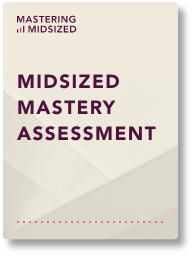Intro
Three areas of focus.
Nine drivers of growth.
Winning companies create mastery in areas that their competitors overlook.
Most midsized companies are doing a lot of things right. But there are also big areas of opportunities.
Through rigorous research of what drives sustainable growth in midsized firms, we have codified our finding into The Midsized Mastery Method. This method defines an approach that midsized companies that want to grow can apply. We don’t reinvent the wheel with every engagement.
Overview
The Midsized Mastery Method
Our research shows that systematically investing and improving in these three focus areas and nine growth drivers propels growth.
Focus Area
Planning &
Execution
Driver 4
Planning and
Managing to Plan
Driver 5
Data-Driven Decisions
Driver 6
Finance Capability
Focus Area
Go-To-
Market
Driver 7
Market Intelligence
Driver 8
Strategic Growth
Driver 9
Systematic Sales and Marketing
Three Areas of Focus Nine Drivers of Growth
People
Recruiting
Systematically recruit high-quality talent at all levels
Great people – the most talented people – drive growth faster, creating midsized companies that are stronger than their competition.
Midsized companies that commit to a systematic recruiting process make talent a competitive advantage.
Developing Talent
Investing in your highest-potential people drives growth
Midsized companies have a strategic advantage: they can make more meaningful investments in professional development than small businesses, and they can make it more personal – and thus more effective – than big business.
You can create customized professional development programs for high-potential employees and reward them with one-on-one coaching and challenging work assignments. Providing high-potentials with more accelerated career paths can be highly motivating, as they can see that the distance to important, coveted roles is relatively short.
Developing even four or five of your best people to become company rock stars, significantly increases the chances that your company’s growth will rocket up the charts.
Leading with teams
Teams – not individuals – lead the organization
Leaders at all levels of the strongest midsized companies must make the journey from being an individual hero to working collaboratively to lead teams. The work in midsized companies is too complex and too interdependent to rely on a single leader.
The strongest midsized companies intentionally strengthen their teams’ ability to perform to consistently drive growth.
Planning & Execution
Planning and Managing to Plan
Clarity about your direction and the exact steps to get there
The most successful midsized businesses create higher-level strategic plans that look forward 3-5 years, and separate shorter-term operational plans that clarify activities in the year ahead.
Midsized firms can’t just react. They must have clarity about goals on precise time horizons, identify the exact steps they will take to get there and assign accountability for who is leading and supporting these efforts within the company. Work ranges from ongoing validation of the business model all the way down to planning day-to-day operations. It is important to choose the right amount of planning and governance at the right levels.
Implementing a planning method such as The One Page Business Plan is a piece of this driver.
Data-Driven Decisions
Successful midsized businesses can’t rely on instinct to grow
With the right data, you know when and how to take the appropriate risks and actions that will drive your company to successful growth.
Midsized companies must excel at collecting and leveraging data not just on financials, but on production, sales, employees, vendors and the customer experience. To create predictable growth, it’s essential to build systems that create and scale data collection and usage. Knowing how to analyze it and benchmark it are necessary in making the decisions that drive growth.
Building a data driven organization is a big undertaking, but absolutely essential for systematic growth.
Finance Capability
Forward-thinking financial leadership
Successful midsized businesses rely on leaders who clearly understand their financial wherewithal, who can accurately forecast what resources will be required to drive growth. It’s essential to making appropriate investments – but not getting over-extended.
As businesses mature, accounting and finance functions must not only record history with accuracy but anticipate the informational and financial needs for the future. Midsized firms go beyond “the accounting department” to have clearly defined functions for finance and treasury as well as accounting. Finance and budgeting play a pivotal role in decision making across the organization.
Go-To-Market
Market Intelligence
Understanding customers, competitors, talent and vendors
Small businesses can sometimes “feel” what’s going on in the market. But at midsized, with dozens or hundreds of people on the front lines — and throughout the organization – understanding needs to be systematized.
The top midsized companies track and analyze shifting marketplace conditions, and use that intelligence as a competitive advantage to stay ahead of the competition, anticipate market trends and attract the best talent and partners.
Strategic Growth
New markets, new products and M&A
Companies need to look for opportunities to enter new markets, launch new products and attract new customers.
Midsized companies need a pipeline of innovative ideas that lead to new revenue streams. Sometimes these ideas can be implemented successfully with existing resources. Often, firms can accelerate growth in bigger leaps by buying companies or creating strategic partnerships with other businesses.
We show you how to systematically look for and execute opportunities to ensure that your company takes a big leap forward, not a leap into the abyss.
Systematic Sales and Marketing
The right systems and tools deliver predictable, positive results
Sales superstars can be useful, but they are not scalable. You can’t recruit enough of them to drive your company from, say, $50 to $100 million. If you want predictable growth, it’s important to clearly define roles and responsibilities such as effective sales managers, territories and expertise on specific products and services.
Sales must understand how to pursue the highest potential targets and opportunities, and how to connect with customers. Marketing needs to support sales with the right messages and materials that address what customers really want and need.
Lead generation and lead nurturing also needs to be systematic, leveraging technology, such as CRM and marketing automation platforms.

